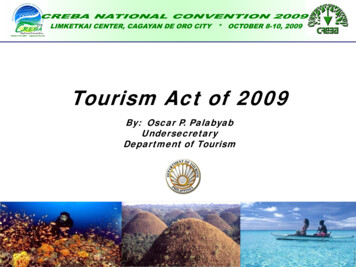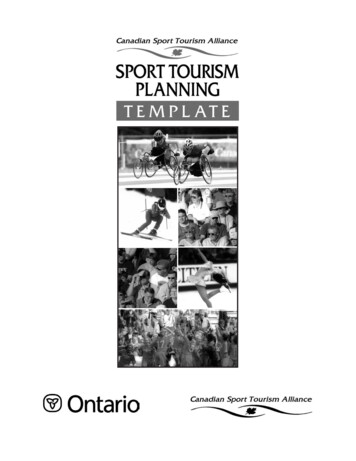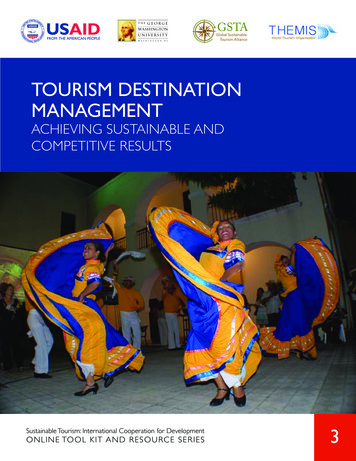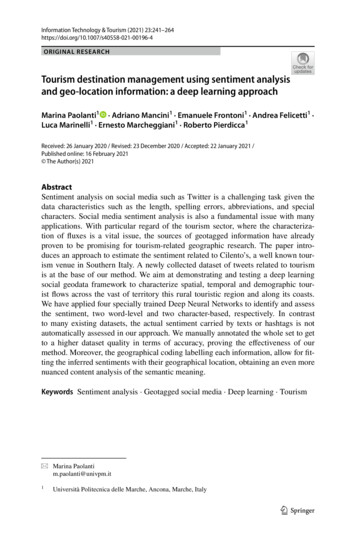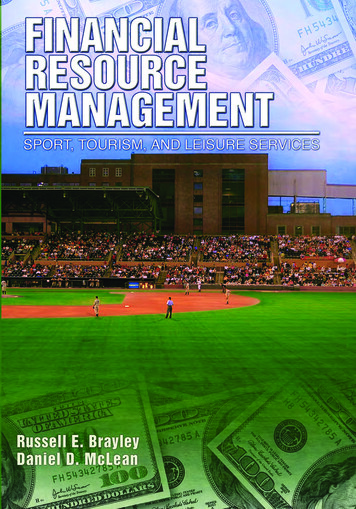
Transcription
Financial Resource ManagementSport, Tourism, and LeisureServicesRussell E. BrayleyandDaniel D. McLeanSagamore Publishing, L.L.C.Champaign, Illinois
2008 Sagamore Publishing LLCAll rights reserved.Publishers: Joseph J. Bannon/Peter BannonGeneral Manager: Doug SandersProduction Manager: Jose HernandezCover Design: Jose HernandezCover Images: Copyrigth tm-media 2008used under license from Shutterstock, Inc.Interior Design: Michelle DressenLibrary of Congress Catalog Card Number: 2008930928ISBN print edition: 978-1-57167-557-6ISBN ebook: 978-1-57167-603-0Printed in the United States.Sagamore Publishing LLC1807 N Federal Dr.Urbana, IL 61801www.sagamorepub.com
DedicationTo Our Families:Renée, Doug, Austin, Erika, Natalie– Russell BrayleyJoAnn, Donna, Jennifer, Suzanne, Timothy,Sally, Michael, Kristine– Daniel McLean
TA B L E O F C O N T E N T SPREFACE. xvSECTION A - FINANCIAL MANAGEMENT IN CONTEXT . 1CHAPTER 1. Financial Management in Public, Private Not-for-Profit, andCommercial Sport, Tourism, and Leisure Service Organizations . 3Introduction . 3Public Enterprises. 3Legislative/Legal Parameters . 4Social Roles/Expectations . 4Market Management Techniques . 4Indicators of Success . 5Financial Management Opportunities and Challenges . 5Other . 5Private Not-for-Profit Enterprises . 6Legislative/Legal Parameters . 6Social Roles/Expectations . 7Market Management Techniques . 7Indicators of Success . 7Financial Management Opportunities and Challenges . 7Other . 8Commercial Enterprises . 8Legislative/Legal Parameters . 8Social Roles/Expectations . 8Market Management Techniques . 9Indicators of Success . 9Financial Management Opportunities and Challenges . 9Competition and Cooperation . 10Summary . 11CHAPTER 2. Financial Management in Public and Not-for-Profit LeisureService Organizations . 13Introduction . 13Public Leisure Service Enterprises . 13Organizational Structure . 13Operational and Fiscal Authority . 14Financial Objectives . 15Debt Management . 15Accounting Management . 16Reporting . 16Performance Evaluation . 16Not-For-Profit Leisure Service Enterprises . 17Organizational Structure . 17Financial Objectives . 17Debt and Account Management . 17Reporting . 18Performance Evaluation . 18Summary . 19CHAPTER 3. Financial Management in Sport Organizations . 21Introduction . 21Sport as an Industry . 22Public Subsidization of Sport Facilities . 23v
Television Ratings and Broadcasting Fees . 24Franchise Values and Player Salaries . 25Attendance Costs of Sporting Events. 27Summary . 29References . 29CHAPTER 4. Financial Management in Tourism and Commercial Recreation Organizations . 31Introduction . 31Financial Objectives . 32Debt and Inventory Management . 32Account Management . 33Reporting . 33Performance Evaluation . 34Summary . 34SECTION B - ORGANIZATION . 35CHAPTER 5. Functions . 37Introduction . 37Financial Responsibility. 38Financial Functions of the Organization. 38Director of Finance . 39Controller (also called “Comptroller”) . 39Treasurer . 39Assessor . 39Purchasing Agent . 39Auditor . 40Summary . 40CHAPTER 6. Departmentalization . 43Introduction . 43Organization for Financial Management in the Public Sector . 43Organization for Financial Management in the Private-Not-for-Profit and Commercial Sectors . 45Program, Unit Involvement in Financial Management . 45Politics and the Financial Management Organization . 49Summary. 50SECTION C - ECONOMICS . 51CHAPTER 7. Economic Principles . 53Introduction . 53Supply and Demand . 54Estimating Supply and Demand . 57Inflation . 60Interest . 62Future Value . 63Present Value . 65Depreciation . 65Sensitivity to Changes in Price . 67Economic Impacts . 70Summary . 73SECTION D - REVENUE MANAGEMENT . 75CHAPTER 8. Revenue Sources . 77Introduction . 77Types of Income Sources . 77vi
Compulsory Income Sources . 79Types of State and Municipal Taxes . 79Other Sources of Compulsory Income . 84Federal Government Sources . 87Gratuitous Income . 88Earned Income. 88Investment Income. 90Contractual Receipts . 91Partnerships and Collaborations . 91Revenue Structure Plan . 93Summary . 94References . 95CHAPTER 9. Pricing . 97Introduction . 97Purposes of Pricing . 97Pricing to Recover Costs. 97Pricing to Create New Resources (Added Value Pricing) . 98Pricing to Establish Value . 98Pricing to Influence Behavior . 98Pricing to Promote Efficiency . 99Pricing to Promote Equity . 99The Appropriateness and Feasibility of Pricing . 100The Nature of Price . 101Monetary Price. 101Opportunity Price. 102Psychological Price . 102Effort Price . 102Approaches to Establishing Price . 103Calculating Costs for Unit Pricing . 104Subsidization and Unit Pricing . 106Other Considerations in Establishing Price . 107Willingness to Pay/The Going Rate. 108Sensitivity to Changes in Price . 109Adjusting Prices . 110Summary . 111CHAPTER 10. Grantseeking . 113Introduction . 113Why Pursue Grants? . 113The Granting Environment . 114The Grantseeking Process . 116Step 1: Identifying a Potential Idea . 116Step 2: Discovery, Selection, and Contact with a Granting Agency . 117Step 3: Preparation of the Grant Proposal . 121Step 4: Submitting the Grant Proposal . 129Step 5: Grantmaker’s Decision . 129Step 6: Grant Administration . 130Summary . 131References . 131CHAPTER 11. Philanthropy and Fundraising . 133Introduction . 133Philanthropy . 133Why Fundraising is Important . 134The Role of Fund Development . 135vii
Why People Give . 136Charitable Organizations . 136Activities of a Charitable Organization Established to Support the Park System . 137Fund Development. 137Fundraising Sources . 140Goal Setting, Relationships, and the Gift Pyramid . 141Goal Setting . 143The Gift Pyramid . 143Fundraising Strategies. 144Annual Campaigns . 145Planned Giving . 146Special Events . 148Support Organizations . 149Selecting Fundraising Strategies . 150Summary . 150References . 151CHAPTER 12. Sponsorship . 153Introduction . 153Causes of Sport Sponsorship Growth . 155Setting Sponsorship Objectives . 158Sponsorship: The Corporate Perspective . 160Sponsorship Acquisition: The Sport Organization’s Perspective. 161Selling the Sponsorship Opportunity . 162The Sponsorship Proposal Document . 163Marketing Benefits of Sponsorship . 163Cross Promotions . 164Virtual Advertising . 164Hospitality . 164Evaluation . 164Summary . 166References . 166SECTION E - EXPENDITURE MANAGEMENT. 169CHAPTER 13. Budgeting Basics . 171Introduction . 171Budget Construction Guidelines . 171Gathering Information . 172Identifying the Budget Goal . 173Essential Information . 173Gathering New Information . 173Organizing the Data . 173Determining Costs .
Financial management functions and roles within the organizational structure . 38 6.1. Basic organizational chart emphasizing financial management unit . 44 6.2. Units within a public leisure servic


